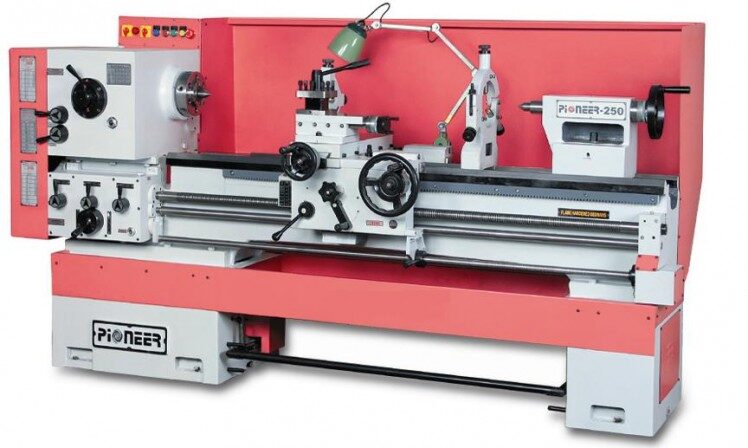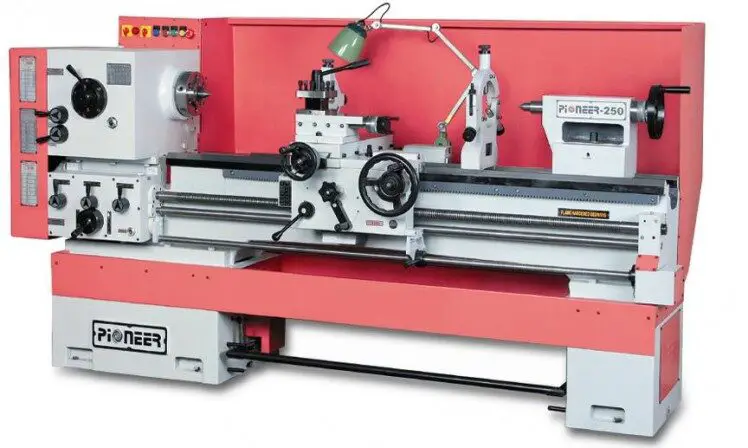Are you curious about what a tool room lathe machine is? Well, let me break it down for you in simple terms! A tool room lathe machine is a versatile and powerful tool used in manufacturing and engineering. It’s like a superhero in the world of metalworking!
Picture this: you have a piece of metal, and you want to shape it into something useful like a bolt or a gear. That’s where the tool room lathe machine comes in. It spins the metal at high speeds while a cutting tool shapes it into the desired form. It’s like a sculptor turning a block of marble into a magnificent sculpture!
Now, you might wonder, what makes a tool room lathe machine different from other types of lathes? Great question! Unlike other lathes, the tool room lathe machine is designed for precision and accuracy. It’s your go-to buddy when you need to create intricate and complex parts with tight tolerances.
So, whether you’re a curious mind or an aspiring engineer, understanding what a tool room lathe machine is can open up a whole new world of possibilities. Get ready to dive into the fascinating world of metalworking where you can turn your imagination into reality!

What is a Tool Room Lathe Machine?
A tool room lathe machine is a versatile and precise tool used in machining and manufacturing processes. It is commonly used in tool rooms, small-scale workshops, and educational institutions for various turning operations. With its ability to fabricate complex parts, the tool room lathe machine is an essential tool in the manufacturing industry.
Components of a Tool Room Lathe Machine
A tool room lathe machine consists of several key components that work together to perform various turning operations. These components include:
- Bed: The bed is the base of the lathe machine and provides support and rigidity. It is usually made of cast iron and has guide-ways to accommodate the carriage and tailstock.
- Headstock: The headstock houses the main spindle, which is responsible for rotating the workpiece. It also contains various gears and pulleys for controlling the speed of rotation.
- Carriage: The carriage is the moving part of the lathe machine that holds the cutting tool and moves along the bed to perform turning operations. It consists of the saddle, cross-slide, and tool post.
- Tailstock: The tailstock is used to support the other end of the workpiece and provides stability during machining. It can be adjusted for different length requirements and may also have a live center for additional support.
- Chuck: The chuck is a specialized device that holds the workpiece securely while it rotates during machining. It allows for easy and accurate clamping and unclamping of the workpiece.
- Tool Post: The tool post is an essential component that holds the cutting tools in place. It can be adjusted to change the position and angle of the tool, allowing for precise machining.
- Feed Mechanism: The feed mechanism moves the carriage along the bed to perform cutting operations. It can be controlled manually or through automation, depending on the machine’s capabilities.
These components work together to provide the necessary tools and functions to produce precise and complex parts using a tool room lathe machine.
Types of Tool Room Lathe Machines
There are various types of tool room lathe machines available, each designed for specific applications and machining requirements. Some common types include:
1. Engine Lathe: Engine lathes are versatile and widely used in tool rooms. They are capable of handling a wide range of turning operations and are suitable for both small-scale and large-scale production.
2. Precision Lathe: Precision lathes are known for their high accuracy and excellent surface finish. They are often used in industries that require tight tolerances, such as aerospace and medical equipment manufacturing.
3. Turret Lathe: Turret lathes are equipped with a turret tool post that holds multiple tools simultaneously. This allows for quick tool changes and increased efficiency in production environments.
4. CNC Lathe: CNC lathes are automated machines that use computer numerical control (CNC) to control the machining process. They offer precise and repeatable machining capabilities, making them suitable for high-volume production.
5. Multi-axis Lathe: Multi-axis lathes have the ability to perform turning operations on multiple axes, allowing for the production of complex parts with intricate designs.
Benefits of Using a Tool Room Lathe Machine
Using a tool room lathe machine offers several benefits in machining and manufacturing processes. Some of the key benefits include:
- Precision: Tool room lathes are known for their high accuracy and precision. They can produce parts with tight tolerances, ensuring a perfect fit and finish.
- Versatility: Tool room lathes are capable of performing a wide range of turning operations, from simple cylindrical turning to complex contouring. This versatility allows for the production of various parts and components.
- Efficiency: The ability to automate certain operations, especially with CNC lathes, increases efficiency and reduces manual labor. This results in faster production times and improved productivity.
- Flexibility: Tool room lathes can accommodate different types of materials, from metals to plastics, and can handle various sizes and shapes of workpieces. This flexibility makes them suitable for a wide range of applications.
- Cost-effectiveness: Tool room lathes offer a cost-effective solution for producing small to medium-sized batches of parts. They eliminate the need for outsourcing and allow for in-house manufacturing, reducing costs in the long run.
These benefits make tool room lathe machines a valuable asset in the manufacturing industry, providing precision, versatility, and efficiency in machining operations.
Key Takeaways: What is Tool Room Lathe Machine?
- A tool room lathe machine is a type of machine tool used in manufacturing and metalworking industries.
- It is used to shape and cut materials such as metal, wood, and plastic into various shapes and sizes.
- Tool room lathes are known for their versatility and precision, allowing for the production of intricate parts and components.
- These machines are commonly used in tool rooms, mechanical workshops, and industries where precise machining is required.
- Tool room lathe machines are operated manually or with the help of computer numerical control (CNC) systems for greater accuracy and efficiency.
Frequently Asked Questions
Welcome to our FAQ section about tool room lathe machines! If you’re curious about these versatile machines used in various industries, you’ve come to the right place. Below, you’ll find answers to some common questions people have about tool room lathe machines.
1. How does a tool room lathe machine differ from a regular lathe machine?
A tool room lathe machine is specifically designed for precision machining and manufacturing of tooling, prototypes, and small batches. Unlike regular lathe machines, tool room lathes often have a higher level of accuracy, rigidity, and versatility. They are equipped with features like power feeds, quick-change tooling, and digital readouts, allowing for greater control and precision in machining operations.
Additionally, tool room lathes typically have a wide range of spindle speeds and feed rates, enabling operators to work with various materials and achieve different surface finishes. Their construction and design emphasize durability and stability, making them suitable for a wide range of machining applications.
2. What are the main applications of tool room lathe machines?
Tool room lathe machines are extensively used in industries such as aerospace, automotive, and medical, where precise machining and manufacturing are crucial. They are ideal for producing precision parts, tooling, and prototypes with tight tolerances. Tool room lathes are commonly used for turning, facing, drilling, boring, threading, and tapering operations.
These machines are versatile and can work with various materials, including metals, plastics, and composites. They are often used to manufacture components like shafts, bushings, valves, gears, and custom tooling. Tool room lathe machines play a vital role in maintaining the quality and precision of parts and tooling used in a range of industries.
3. Are tool room lathe machines suitable for beginners?
While tool room lathe machines may seem intimidating at first, they can be suitable for beginners with the right training and guidance. It’s important for beginners to receive proper instruction on machine operation, safety protocols, and basic machining techniques.
Once beginners have a solid understanding of the fundamentals, they can start using tool room lathes for simpler machining tasks. With practice and experience, they can gradually tackle more complex projects. Starting with smaller parts and working under supervision can help beginners build confidence and develop their machining skills.
4. What are the key features to consider when buying a tool room lathe machine?
When purchasing a tool room lathe machine, several key features should be considered. These include:
– Power and spindle speed: Look for a machine with sufficient power and a wide range of spindle speeds to accommodate your machining needs.
– Bed length and swing over bed: Consider the maximum length of the parts you’ll be machining and choose a machine with an appropriate bed length and swing over bed.
– Tooling options: Check for quick-change tooling systems and the availability of tool holders and accessories to enhance efficiency and versatility.
– Control system: Look for a lathe machine with a user-friendly control system and digital readouts for precise adjustments.
– Rigidity and stability: Ensure the machine is constructed with high-quality materials and has a sturdy design for accurate and stable machining.
5. How should I maintain a tool room lathe machine for optimal performance?
Maintaining a tool room lathe machine is essential for its optimal performance and longevity. Here are some maintenance tips:
– Regular cleaning: Keep the machine clean from debris, chips, and coolant. This helps prevent damage to the components and ensures smooth operation.
– Lubrication: Follow the manufacturer’s recommendations for lubricating various parts of the machine to reduce friction and extend the machine’s lifespan.
– Regular inspection: Check for any signs of wear or damage to components such as belts, gears, and bearings. Address any issues promptly to avoid further damage or breakdown.
– Calibration: Periodically check and calibrate the machine’s accuracy using precision measuring tools to maintain the desired level of precision in your machining operations.
– Training: Continuously train and educate operators on proper machine operation and safety protocols to prevent accidents and ensure efficient and effective use of the machine.

Summary
A tool room lathe machine is a type of machine used to shape and cut metal. It has a sturdy construction and a variety of features that make it ideal for precision work. This machine is commonly used in workshops and manufacturing facilities. Tool room lathes have a compact size and can perform various operations like turning, facing, and threading. They are designed for accuracy and can produce high-quality parts. With the ability to handle different materials and sizes, tool room lathes are essential tools for creating precise and intricate metal components.
